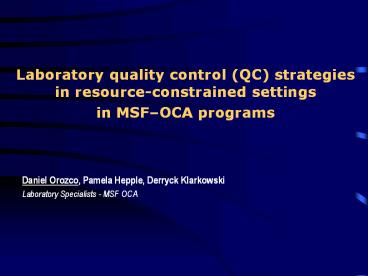Laboratory quality control (QC) strategies in resource-constrained settings in MSF - PowerPoint PPT Presentation
1 / 20
Title:
Laboratory quality control (QC) strategies in resource-constrained settings in MSF
Description:
Laboratory quality control (QC) strategies in resource-constrained settings in MSF OCA programs Daniel Orozco, Pamela Hepple, Derryck Klarkowski – PowerPoint PPT presentation
Number of Views:197
Avg rating:3.0/5.0
Title: Laboratory quality control (QC) strategies in resource-constrained settings in MSF
1
Laboratory quality control (QC) strategies in
resource-constrained settings in MSFOCA
programs
- Daniel Orozco, Pamela Hepple, Derryck Klarkowski
- Laboratory Specialists - MSF OCA
2
(No Transcript)
3
Basic health care laboratories Malaria/TB
microscopy
4
Secondary level labs for TB/ HIV programs
5
High technology labs MDR - TB program Uzbekistan
6
Background
- Pre-2005 quality of lab performance within MSF
OCA labs was unknown - We identified the need to set up a standardized
QC system - Goals of the programme
- Monitor performance
- Identify poor performers
- Provide clinical staff with information on the
accuracy of laboratory results
7
Background
- Program design - Field/HQ input for practicality
- QC protocol implemented in 2005
- Key element is the central reporting system,
which enables effective management - Immediate finding
- Wide diversity of performance
- Unacceptable number of centers were performing
poorly - 2005 2007 Significant improvement across the
lab network
8
Scope
- Malaria, TB, Kala Azar, Cutaneous Leishmaniasis
and HIV applying similar principles - We also have a separate QC methodology for
Chemistry, Hematology and CD4 testing
9
QC Methodology
10
QC Methodology
- Monthly random selection
- Based on crosschecking
- Results are sent to Amsterdam
- Analyzed using agreement, false positivity and
false negativity
11
QC Methodology
- Based on a small sample size
- 5 weak positives 5 negatives
- To limit workload for laboratory staff
- Limited reference laboratory capacity
- The small sample size is compensated for by
- Targeting weak positives, where errors are most
likely to occur - 4-month cohort analysis (40 slides)
12
Analysis
- agreement
- false positives/false negatives
- Quartile analysis
- Compliance
- The statistical analysis has been validated
by WHO (LSHTM).
13
Results
- Between 2005 2007
- - 748 QC monthly reports for malaria from 70
centres - - 33,346 slides
- Currently, 40 centers centrally reporting (20
countries)
14
(No Transcript)
15
(No Transcript)
16
Results Improvement
- QC alone does not improve performance, but is
part of a package auditing system Standard
Indicators, Equipment, reagents,
Infrastructure,Training, in-situ support - Progressively strengthening Quality Assurance
(QA). E.g. malaria manual, Standard Indicators
Reports (SIR), upgrading QC database software
17
Improvement
- Identification of weak performers and corrective
action taken - Our QC programme created a healthy competition
by comparing centres against each other, which
are working under similar circumstances
18
(No Transcript)
19
Conclusions
- Sustainable method for resource-constrained
settings. Practical and with minimal investment - Statistically valid
- Successful - e.g. for Malaria
- Median increased from 90 to 100
- 1st quartile increased from 86 to 97
- Supports accuracy of diagnosis and operational
research
20
Conclusions
- Demands commitment
- from field staff for continuous operation
- lab specialists for central monitoring by
issuing compliance and benchmarking reports - Depends upon support from Medical Director, Head
PHD and CMTs for its implementation and follow
up.































